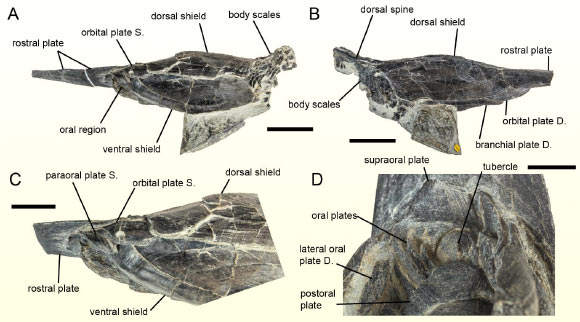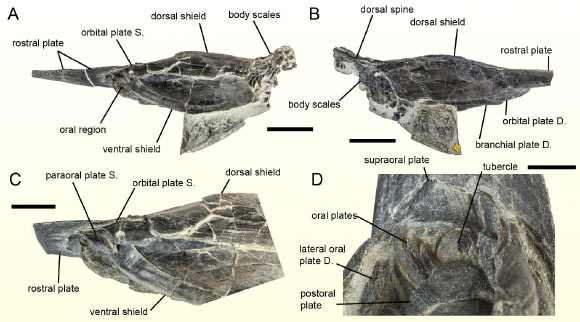In new analysis, paleontologists used X-ray microtomography to characterize the feeding equipment of an exceptionally well-preserved specimen of the Early Devonian jawless fish Rhinopteraspis dunensis.

Rhinopteraspis dunensis. Picture credit score: Dearden et al., doi: 10.1098/rspb.2023.2258.
Feeding behaviors are generally utilized by scientists to assist piece collectively early evolution of vertebrates, and totally different jaw shapes and constructions can recommend a broad vary of feeding methods.
Within the absence of jaws, many competing theories have been developed starting from biting and slicing, to filtering meals from sediment or water.
In a brand new examine, College of Birmingham paleontologist Ivan Sansom and his colleagues have been in a position to visualize the mouth elements of one in every of these jawless fish, Rhinopteraspis dunensis, intimately.
The pictures revealed the construction and association of finger-like bones that undertaking from the decrease ‘lip’ of the animal’s mouth, which the scientists consider acted to regulate the mouth’s measurement and form because it captured meals particles from surrounding water.
“The appliance of CT scanning methods to the examine of fossil fish is revealing a lot new details about these historical vertebrates and giving us the chance to review treasured and distinctive specimens with out harmful investigation,” Dr. Sansom mentioned.
“On this case, these strategies have allowed us to suit all the small bones of this animal’s mouth collectively, and try to perceive the way it fed from this built-in system quite than through the use of remoted bones,” mentioned Dr. Richard Dearden, a researcher on the College of Birmingham and the Naturalis Biodiversity Heart.
“As a substitute of a gradual pattern in direction of ‘lively meals acquisition’ — scavenging or searching — we see an actual range and vary of feeding behaviors amongst our earliest vertebrate kin.”
The reconstruction produced by the researchers reveals that the bony plates across the mouth would have had restricted motion, making it unlikely that the animals have been hunters able to ‘biting.’
Together with an elongated snout, they might even have discovered it troublesome to scoop and filter sediment immediately from the underside of the ocean.
Nevertheless these plates would have allowed it to regulate opening of the mouth, and maybe pressure meals from water in a approach additionally utilized by animals equivalent to flamingos or oysters.
The findings provide a brand new perspective on theories of vertebrate evolution, since present hypotheses argue that long run evolutionary traits transfer from passive meals consumption to more and more predatory conduct.
In distinction, the examine means that in truth, early vertebrates had a broad vary of various feeding behaviors lengthy earlier than jawed animals began to seem.
“The useful morphology of the equipment in Rhinopteraspis dunensis precludes all proposed interpretations of feeding apart from suspension/deposit feeding and we interpret the equipment as having served primarily to average the oral gape,” the authors concluded.
“That is in line with proof that no less than some early jawless gnathostomes have been suspension feeders and runs opposite to macroecological situations that envisage early vertebrate evolution as characterised by a directional pattern in direction of more and more lively meals acquisition.”
The examine was printed within the Proceedings of the Royal Society B.
_____
Richard P. Dearden et al. 2024. The three-dimensionally articulated oral equipment of a Devonian heterostracan sheds mild on feeding in Palaeozoic jawless fishes. Proc. R. Soc. B 291 (2019): 20232258; doi: 10.1098/rspb.2023.2258



